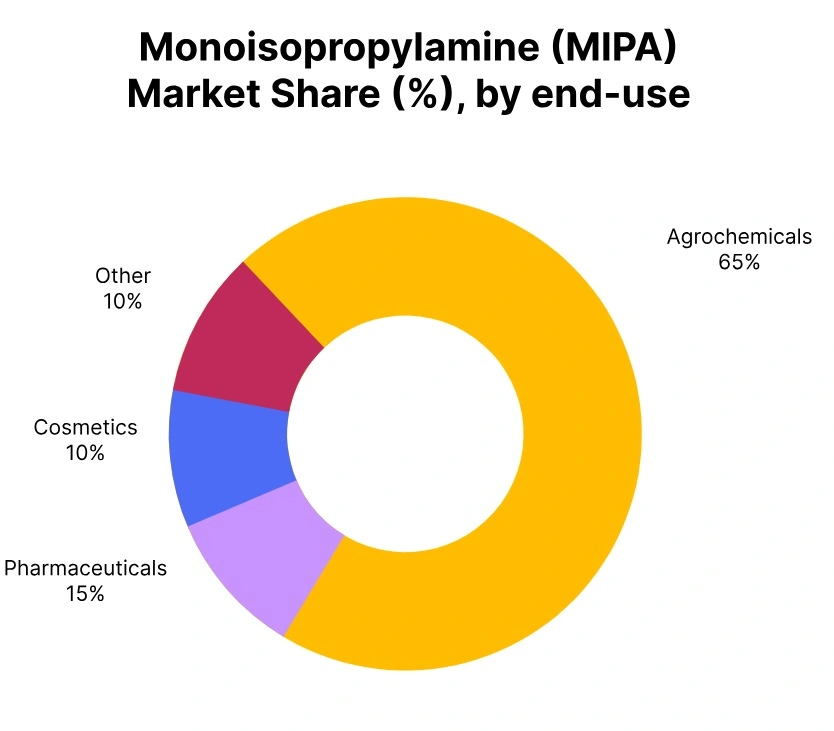Price-Watch’s most active coverage of Monoisopropylamine (MIPA) price assessment:
- 70% Industrial Grade FOB Shanghai, China
- 70% Industrial Grade CIF Haydarpasa_China, Turkey
- 70% Industrial Grade FOB Texas, USA
- 70% Industrial Grade CIF Santos_USA, Brazil
- 70% Industrial Grade CIF JNPT_China, India
- 70% Industrial Grade CIF JNPT_USA, India
Monoisopropylamine (MIPA) Price Trend Q3 2025
In Q3 2025, Monoisopropylamine (MIPA) price trends across major markets showed mixed performance. Monoisopropylamine price in China dipped by 5.3%, softening further after a sharper 10.4% drop in Q2, driven by weak international demand and high inventories.
Monoisopropylamine price in India declined by 3% for Chinese imports, while U.S. imports rose 0.7%, reflecting a relatively stable market. In the USA, prices edged up by 0.3%, supported by consistent exports and stable costs.
Monoisopropylamine (MIPA) price in Turkey fell 5% amid subdued downstream demand, whereas Monoisopropylamine price in Brazil went up by 1% due to steady U.S. shipments. Monoisopropylamine price in September 2025 reflected these divergent trends, shaped by varying demand in textile, agrochemical, and pharmaceutical sectors across regions.
China
Monoisopropylamine (MIPA) Export Prices FOB Shanghai, China, Grade- (70%) Industrial Grade.
According to Price-Watch, in Q3 2025, Monoisopropylamine price in China kept declining, registering a 5.3% drop compared to the steeper 10.4% decrease in Q2. The Monoisopropylamine (MIPA) price trend in China reflected ongoing weakness in international demand, particularly from key sectors like textile, agrochemical, and pharmaceutical industries, which lessened procurement amid economic uncertainties.
Exporters in China faced mounting pressure from high inventory levels and sluggish global offtake, despite efforts to adjust pricing strategies. Lower raw material costs further contributed to the bearish pricing environment. Monoisopropylamine price in September 2025 remained subdued, showing slight signs of recovery as international buyers remained cautious. The quarter highlighted a softer export market environment, with expectations of improved demand in late Q4 depending on downstream recovery trends.
India
Monoisopropylamine (MIPA) Import prices CIF JNPT, India, Grade- (70%) Industrial Grade.
According to Price-Watch, in Q3 2025, Monoisopropylamine price in India showed light fluctuation, with a mixed impact from Chinese and U.S. imports. The Monoisopropylamine (MIPA) price trend in India declined by 3% for Chinese-origin imports compared to the previous quarter, while U.S.-origin imports rose marginally by 0.7%.
Overall, the market remained relatively balanced amid steady downstream demand from the textile, agrochemical, and pharmaceutical sectors. Although local buying activity was moderate, improved freight conditions and consistent supply helped stabilize pricing.
The Monoisopropylamine price in September 2025 reflected this equilibrium, avoiding significant volatility. End-use industries maintained regular procurement levels, ensuring demand continuity. Looking forward, stable raw material availability and cautious industrial restocking are likely to guide market direction in the coming quarter.
USA
Monoisopropylamine (MIPA) Export Prices FOB Texas, USA, Grade- (70%) Industrial Grade
In Q3 2025, Monoisopropylamine (MIPA) price in the USA showed slight improvement, rising by 0.3% following a 2.1% decline in Q2. The Monoisopropylamine (MIPA) price trend in the USA was supported by consistent export activity and gradual recovery in demand from global agrochemical and pharmaceutical sectors, though textile industry consumption remained mostly muted.
Exporters in the U.S. benefited from stable production costs and favourable freight conditions, which helped sustain pricing despite moderate market challenges. Monoisopropylamine price in September 2025 held steady, reflecting balanced supply-demand dynamics and healthy buyer sentiment in select markets. When compared to Q2, the U.S. market showed signs of stabilization, with industry participants carefully optimistic about further recovery in export volumes during the final quarter of the year.
Turkey
Monoisopropylamine (MIPA) Import prices CIF Haydarpasa, Turkey, Grade- (70%) Industrial Grade.
In Q3 2025, Monoisopropylamine price in Turkey declined by 5% compared to the previous quarter, largely due to reduced demand and competitive pricing from Chinese exporters. The Monoisopropylamine (MIPA) price trend in Turkey showed subdued activity in key downstream sectors such as the textile, agrochemical, and pharmaceutical industries.
Sufficient inventories and stable shipping conditions from China also contributed to the soft pricing environment. Despite steady raw material availability, weaker industrial activity and cautious purchasing behavior impacted the overall market sentiment. The Monoisopropylamine price in September 2025 continued to show a downward trend, indicating a market still in correction mode after stronger Q2 imports.
Brazil
Monoisopropylamine (MIPA) Import prices CIF Santos, Brazil, Grade- (70%) Industrial Grade.
In Q3 2025, Monoisopropylamine price in Brazil saw a slight 1% increase from the previous quarter, supported by steady demand and firm import volumes from the USA. The Monoisopropylamine (MIPA) price trend in Brazil was shaped by balanced supply conditions and sustained consumption from end-use sectors like pharmaceutical, textile, and agrochemical.
Logistics from the USA remained steady, minimizing any major disruption in supply chains. Additionally, mild currency fluctuations did not significantly impact procurement costs. The Monoisopropylamine price in September 2025 reflected this marginal rise, indicating a stable yet careful market outlook heading into the final quarter of the year.




